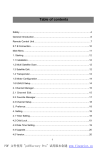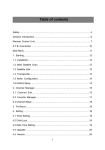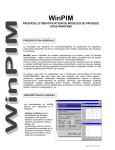Download [txt] - inive
Transcript
The Heating Curve Adjustment Method Clima 2000 paper P343 topic 10 "Software" W. Kornaat and H.C. Peitsman TNO Building and Construction Research The Netherlands The Heating Curve Adjustment Method by W. Kornaat H.C. Peitsman (phone +31 15 2608568, fax +31 15 2608432) (phone +31 15 2608518, fax +31 15 2608432) TNO Building and Construction Research The Netherlands Introduction In apartment buildings with a collective heating system usually a weather compensator is used for controlling the heat delivery to the various apartments. With this weather compensator the supply water temperature to the apartments is regulated depending on the outside air temperature. With decreasing outside air temperature, the supply water temperature is increased because of the increase in the heat demand. The relation between the supply water temperature and outside air temperature is called the heating curve. After implementation these heating curves are usually set according to the design of the heating system. Often there is no check whether this setting is indeed correct in practice. Due to safety marges in the design, in practice often a some what lower heating curve is possible. Furthermore in practice adjustments on the heating curves are often used as an easy way to prevent complaints. Heating curves are for instance increased in case of complaints about too low inside air temperatures. The actual cause for the complaints is often not further investigated and the heating curve is often not set back and kept at an unnecessary high level in the future. The result of the above mentioned is that in a lot of situations the setting of the heating curve will not be the optimum for the specific building. This can, amongst other things, lead to thermal discomfort and unnecessary energy consumption. A method for determining the optimum setting of the heating curve in practice is developed by CSTB (France) [1]. With this method an easy and rational optimalisation can be obtained. Within the framework of the Sprint program of the European Community, this method is tested and improved by cooperation between CSTB (France), CSTC (Belgium), IBP (Germany), SINTEF (Norway) and TNO (the Netherlands) [2]. In this article the principle of this method, the performance of this method in practice and the benefits of using the method are described. Error! Unknown switch argument. Principle of the method The method for adjusting the parameters of the heating curve is based on a simplified representation of the system : building / central heating plant / control unit. This means that: • steady-state conditions are assumed; • a linear heat emission of the heat emitters is assumed; • no other terminal control devices (besides the heating curve) are considered or may be active (e.g. all radiator valves need to be fully opened); • the effect of solar radiation is not taken into account. This means that, for a correct determination of the heating curve, situations with important solar radiation need not be considered for the analysis. In steady-state conditions, an energy balance of a building yields : G . V . (Ti - Te) = K . (Tw - Ti) + Ag (1) where : G is the global heat losses coefficient per cubic meter (W/m3.K) V is the volume of the heated zone (m3) K is the heat emission coefficient (W/K) Ti is the mean indoor temperature (°C) Te is the outdoor temperature (°C) Tw is the water flow temperature (°C) Ag are the free heat gains (W) This equation can be arranged as follows, and gives the general form for a heating curve: Tw = a . Te + b (2) a = - G.V / K b = (G.V + K) / K . Ti - Ag / K (3) (4) where : This reasoning shows that an energy balance that takes into account the characteristics of • the building, by way of the parameters G and V; • the installation, by way of the parameters Tw and K; • the climate, by way of the parameters Te; • the thermal comfort, by way of parameter Ti; • the internal situation, by way of parameter Ag; leads to a linear relationship between the water flow temperature Tw and the outdoor air temperature Te. Error! Unknown switch argument. The basic principle of the heating curve adjustment method is: 1) to determine by means of measurements: • the correlation between the supply water temperature to the apartments (maintained by the weather compensator) and the outside air temperature. In formula: Tw = am . Te + bm (5) • and the correlation between the inside air temperature in the apartments and the outside air temperature. In formula: Ti = xm . Te + ym (6) The parameters xm, ym, am, bm, are derived by a least-squares method. 2) to determine, based upon these correlations, with PC software the supply water temperature as function of the outside air temperature, by which the inside air temperature equals the desired value (Tc). The equation (with the layout of formula 2) that can be derived upon the measured correlations is: Tw = (xm - a m ) ⎛ ( a m - 1).(T c - y m ) ⎞ .T e + ⎜ + b m⎟ ⎠ ⎝ ( x m - 1) ( x m - 1) (7) The principle of the heating curve adjustment method is graphically illustrated in figure 1. inside temp= f(outside temp) 30 supply temp= f(outside temp) 100 measured 25 measured heating curve 80 20 60 desired value 15 optimum heating curve 40 10 20 5 0 0 -10 -5 0 5 10 15 20 -10 -5 one or more apartments 0 5 10 15 20 heating plant front view apartment building figure 1: Principle of the heating curve adjustment method Error! Unknown switch argument. Performance of the method in practice The performance of the method in practice consists of 4 parts, namely: 1) short term measurements (continuously monitoring) to determine the correlation between (1) supply water temperature and (2) inside air temperature with the outside air temperature; 2) the determination of the current settings of the weather compensator; 3) the construction of an input file, based upon part 1 and 2, suitable for the computer program WINREG, by which the optimum heating curve will be determined; 4) The analysis and the determination of optimum heating curve with the computer program WINREG. A flow chart of the method is given in figure 2. The various parts of the method are in the following further discussed. Short term measurements Inventory of weather compensator Parameters to be measured: - supply water temperature of the weather compensator - inside air temperature(s) - outside air temperature For instance: - current setting of heating curve - period of night setback - etc Measuring time: 3 to 6 weeks (depending on variation in outside air temperature.) Construction of an input file suitable for determination of the optimum heating curve Using the computer program PREPATV(*) or a common spreadsheet program all measured data plus some extra information needs to be put in the correct format. Analysis and determination of the optimum heating curve Using the computer program WINREG(*) (*) figure 2: both these computer programs are developed specific for the heating curve adjustment method Flow chart of the heating curve adjustment method Error! Unknown switch argument. Short term measurements The following parameters need to be measured: 1) the supply water temperature to the apartments maintained with the weather compensator. This temperature can be accurate enough measured using an, at the outside well insulated, surface sensor attached on the water pipe. This temperature needs to be measured as close as possible to the sensor of the weather compensator. In this way also the functioning of the weather compensator can be checked; 2) the outside air temperature. The outside air temperature needs to be measured on a location shielded from solar radiation. It may be expected that usually a place besides the sensor of the weather compensator will be correct; 3) the inside air temperatures. It is advised to measure the inside air temperature in the living rooms, because these are commonly the most important and occupied rooms. During the measurements the radiator valves need to be fully opened. This is done because in this situation the weather compensator needs to be able to maintain the desired inside air temperature. The software developed for the heating curve adjustment method can handle a maximum of 8 inside air temperatures measured in different apartments. Measuring in more apartments, increases the accuracy of the method. Furthermore by measuring in apartments spread over the apartment building (far and close to the boiler room, on the top floor, the ground floor or an other floor, etc) an insight is gained in the thermal balance in the building. This means occur in different apartments similar inside air temperatures. If this is not the case this can point out an incorrect heat distribution (hydraulic unbalance), local unexpected extra heat losses or local insufficient radiator capacity. These problems need to be tackled in general for creating a good heating system and in special before an optimum heating curve can be determined. Because measurements need to be performed on various locations in the building (see figure 3), a good option is to use several small one or multichannel data loggers. The installation effort per apartment can then be minimized to about half an hour. Several different types of such data loggers are nowadays available. The measurements need to be performed during a period in which a sufficient variation in the outside air temperature occurs on which a good correlation with supply water and inside air temperatures can be made. In practice this comes down to roughly 3 to 6 weeks. Error! Unknown switch argument. heating plant: • supply water temperature • outside air temperature apartments: • inside air temperature measured in a maximum of 8 rooms • with radiator valves fully opend • by prefence measure in livingroom or kitchen • selection of apartments: - close to and far away for heating plant (in relation to distribution heat losses) - with high and low heat demand (apartments on top floor, apartments in the middle of the buidling, etc) - if possible apartments with complaints figure 3: Overview of measurements in front view of apartment building Current setting weather compensator outside air temperature -5C supply water temperature (C The current setting of the weather compensator needs to be determined, such as: 1) the setting of the heating curve; 2) limitations on the heating curve (e.g. 100 maximum limitation maximum limitation at low outside air temperatures, see figure 4); 80 3) period with night setback; 60 4) etc. 40 The setting of the heating curve is of course needed to make a comparison with the measured 20 curve and to evaluate whether the weather actual heating curve compensator on this point functions correctly. 0 The other information is necessary to filter the -20 -10 0 10 20 30 outside air temperature (C) --> measured data. This filtering takes place during the actual determination of the optimum heating figure 4: Inventory of heating curve curve with the computer program WINREG (see later on). For this determination for instance only the measurements during the day are needed. Based upon the period of night setback, the Error! Unknown switch argument. night period (with usually lower heating curve) and the heating up period at the start of the day are determined and ruled out. During the day furthermore only the situations in which the actual heating curve is functioning need to be considered. Periods in which the supply water temperature is limited need not be considered (see figure 4). The measurements with limited supply water temperature will make the correlation incorrect. Construction of the input file As already mentioned the use of several small data loggers is recommended for the measurements. After performing the measurements, the data of these several loggers need to be put in 1 file for further analysis concerning the optimum heating curve. Special attention hereby needs to be given to the time synchronisation. For this purpose a special computer program PREPATV is developed. For a description of this computer program is referred to [3]. A few features of this computer program however does not function well. This can give problems depending upon the used measuring equipment and actual measuring results. A more general option is to construct such an input file using a spreadsheet program. Often a spreadsheet program is already used to visualize the measured data. In this case it is an easy step to arrange the data in the spreadsheet to a format suitable for further optimizing of the heating curve. Analysis and determination of the optimum heating curve (WINREG) The computer program developed for this purpose is called WINREG. For a description of this computer program is referred to [4]. After reading the previous mentioned input file, this computer program first gives a window with general information (see figure 5), such as: location of the measurements (place name); measuring interval (sampling rate); number of measurements (number of samples); period with night setback; current setting of the heating curve (initial controller adjustment); etc. The measured data can be visualized with the program (see figure 6). Error! Unknown switch argument. figure 5: General information concerning the measurements T dep T in1 T out figure 6: Visualization of the measured data in WINREG (T dep= supply water temp, T in1= inside air temp, T out= outside air temp) Error! Unknown switch argument. For the determination of the optimum heating curve the computer program WINREG filters the data, remaining only the necessary data. It is noted however that no data is actually deleted. For the filtering the period of night setback is used, while furthermore in WINREG several filter parameters can be set to maintain only data in which the actual heating curve (see figure 4) is active. Furthermore it is possible to filter out days manual. For instance days with high solar radiation. Due to the effect on the inside air temperature such situations can disturb a correct analysis. Next with the computer program WINREG: the correlation between inside air temperature and outside air temperature is determined. The measurements ( ∇ Tin Mes) and correlation ( Tin Corr) can be graphically presented (see figure 7); the correlation between supply water temperature and outside air temperature is determined. The measurements ( Δ Tdep Mes) and correlation ( Tdep Corr) can be graphically presented (see figure 8); based upon the previous correlations the optimum heating curve is determined. The optimum heating curve ( ¿ Tdep New) and the current heating curve ( Tdep Init) are also visualized in figure 8. Figure 7 shows that in this particular situation the occurring inside air temperatures are too high. The result of the evaluation with the WINREG program is therefor that the heating curve can be set lower as illustrated in figure 8 with 12 to 17°C. figure 7: Correlation between inside air temperature and outside air temperature Error! Unknown switch argument. figure 8: Correlation between supply water temperature and outside air temperature plus the current and optimum heating curve setting. Benefits of the method (results) The primary benefit of the method is to obtain a setting of the weather compensator suited for the specific building. This will contribute to a good thermal comfort in the building. This means in cases, were the heating curve was set too low, adjustments are determined to prevent too low inside temperatures and in cases, were the heating curve was set too high, adjustments are determined to prevent too high inside temperatures. It is our finding that the heating curves in practice are mostly set too high, because adjustments on the heating curves are often used as an easy way to prevent complaints about to loo inside temperatures. In these cases optimizing the setting of the heating curve will also result in a reduction of the energy consumption. Energy savings, due to optimizing (lowering) of the heating curve, is realised by the following issues: 1) a reduction of the boiler heat losses (improvement of the performance coefficient of the boiler). This energy saving is determined to be about 2% of the total energy consumption for heating. This is based upon: • the Dutch ISSO-publication 20, in which the performance coefficients for boilers are given for various situations, amongst which the type of boiler control [5]; • calculations performed with the model of a Dutch boiler manufacturer; Error! Unknown switch argument. 2) 3) a reduction of the transport heat losses. From the Dutch ISSO publication 25 [6] is derived that the heat loss by transport pipes can be reduced with about 20% in case the heating curve is reduced with 10 to 15°C. The actual energy saving now depends per situation on the initial transport heat losses. For an average Dutch situation we have determined that based upon 20% reduction of the heat loss by transport pipes, about 1% on the total energy consumption for heating can be saved; a reduction of the temperature overshoot in the apartments. Due to a high heating curve an overshoot of the air temperatures in the apartments is possible leading to unnecessary energy losses. This overshoot is however hard to calculate and depends on many things, as for instance: the control of the radiators, the dimensions of the radiators, etc. A part of this overshoot can however not be influenced by the users. This is the part when the heat production, caused by the transport pipes in the apartments, exceeds the heat demand of the apartment. The users can not control this heat production by the transport pipes as they can control the heat production through the radiator by closing the radiator valves. For a typical Dutch apartment building is determined that in case the heating curve can be lowered with about 10 to 15°C, an energy saving of 2% of the total energy consumption for heating is reached due to preventing this overshoot that otherwise not can be influenced by the users. In practice higher energy savings are likely because overshoot in general (not only the part that can not be influenced) will be prevented. The sum of these 3 effects add up to a total energy saving of about 5% on the energy consumption for heating, assuming a reduction of the heating curve with about 10 to 15°C. Our research showed that such reductions are often possible. In case of higher or lower reductions the energy saving are of course also higher or lower. As additional benefits can be mentioned: 1) the fact that insight can be obtained in the thermal balance between various apartments. Or in other words whether or not similar inside air temperatures occur in various apartments. If this is not the case this points to an incorrect heat distribution, local not expected extra heat losses, etc. If the thermal balance is not correct, based upon this insight, additional actions can be performed to improve the functioning of the heating installation; 2) the fact that by lowering the heating curve users will have less need to close the radiator valves. This will lead to a better functioning of the central control of the heating system. Error! Unknown switch argument. Demonstration of the method The software programs will be demonstrated during the Clima 2000 congress. Resume The heating curve adjustment method provides an easy way to fit the heating curve for a building, leading to an improvement of the thermal comfort within the building and/or reduction of the energy consumption. Due to the combination of measurements over a 'longer' period and analysis with computer software, a rational adjustment can be determined and made. This is a large improvement in relation with 'manual' adjustments, that are mostly used up to now, based upon occasional findings and/or measurements. It is indicated as an easy way because in total it will cost about 2 or 3 days per building to perform the method. This means installing the measuring equipment, collecting and analyzing the data, determining the optimum heating curve, removing the measuring equipment. Furthermore there are little or no restrictions on the measuring equipment to be used. This means that users can use their own equipment, with which they are familiar. Due to the set up of the method and the guidelines, the method can also be used by people who are less familiar with the technical aspects of heating plants. The method can therefor not only be used by heating engineers and installers, but also for instance by building owners, municipal energy managers, etc. This enlarges the possible use of the method in practice. During our research in the Netherlands, it was our finding that the heating curves were often set much too high. Lowering the heating curves with a least 10 to 15°C was possible in almost all the considered apartment buildings. It is predicted that the use of the heating curve adjustment method in such cases can lead to an energy saving for heating of about 5%. Error! Unknown switch argument. Literature [1] The heating curve adjustment system. S. Nibel CSTB Paris, France September, 1994 [2] Transfer of a heating curve adjustment method and implementation with BEMS. Final report. EC-Sprint program Contract RA 159 ter. March, 1996 [3] PREPATV User manual Presentation and use of the software March, 1996 [4] WINREG User manual Presentation and use of the software March, 1996 [5] ISSO publication 20 Stichting ISSO, Rotterdam [6] ISSO publication 25 Stichting ISSO, Rotterdam Error! Unknown switch argument.




























